Related Research Articles
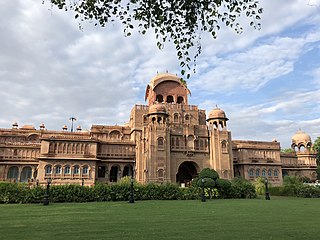
Bikaner is a city in the northwest of the state of Rajasthan, India. It is located 330 kilometres (205 mi) northwest of the state capital, Jaipur. It is the administrative headquarters of Bikaner District and Bikaner division.
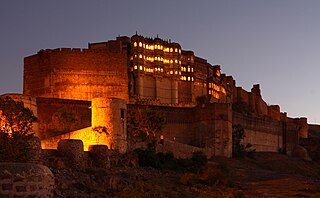
Mehrangarh is a historic fort located in Jodhpur, Rajasthan, India. It stands on a hilltop, rising about 122 m (400 ft) above the surrounding plains, and the complex spans 1,200 acres. It was initially built around 1459 by the Rajput ruler of Rathore clan Rao Jodha, though most of the existing structure is from the 17th century built by his successors. The fort has seven gates, which includes main entrance Jai Pol, built by Maharaja Man Singh to commemorate his victories over the Jaipur and Bikaner armies in 1806. The Fattehpol, commemorates victory of Maharaja Ajit Singh over the Mughals.

Umaid Bhawan Palace, located in Jodhpur, Rajasthan, India, is one of the world's largest private residences. A part of the palace is managed by Taj Hotels. It is named after Maharaja Umaid Singh, grandfather of the present owner, Gaj Singh. The palace has 347 rooms and is the principal residence of the former Jodhpur royal family. A part of the palace is a museum.
Shivraj Singh is an Indian polo player. He is the son of Gaj Singh, the Maharaja of Jodhpur and the grandson of Maharaja Hanwant Singh of Jodhpur and his first wife, Maharani Krishna Kumari of Dhrangadhra.

Junagarh Fort is a fort in the city of Bikaner, Rajasthan, India. The fort was originally called Chintamani and was renamed Junagarh or "Old Fort" in the early 20th century when the ruling family moved to Lalgarh Palace outside the fort limits. It is one of the few major forts in Rajasthan which is not built on a hilltop. The modern city of Bikaner has developed around the fort.

Lalgarh Palace is a palace and heritage hotel in Bikaner, in the Indian state of Rajasthan, built for Sir Ganga Singh, Maharaja of Bikaner, between 1902 and 1926. Laxmi Niwas Palace is a part of Lalgarh Palace but it has been given on lease and recently is being used as a heritage hotel and marriage garden.

Samode Palace, Samode Haveli and Samode Bagh (Garden) are heritage monuments and structures built by the noble feudatory with the hereditary title of 'Maha Rawal' or 'Maha Saheb’ of the Amber and Jaipur principality in Rajasthan, India. All three have rich history of several hundred years and display a fusion of Mughal and Rajasthani art and architecture. They are now part of the Heritage group of hotels under the flagship name of "Samode" that are run by the hereditary owners of these structures. The Samode Palace is located 40 kilometres (25 mi) north of Jaipur city, the Samode Haveli is close to Jaipur (centrally located within city limits, 6 kilometres (3.7 mi) away from the city railway station) and the Samode Bagh or Garden, 4 kilometres (2.5 mi) from the palace which is also run as a luxury hotel.

The Amar Mahal Palace is a palace in Jammu, in the Indian erstwhile Kingdom of Jammu and Kashmir, India. The palace has now been converted into a museum. Commissioned by Maharaja Amar Singh, a Dogra king, the palace was built in the nineteenth century by a French architect on the lines of a French Chateau. The palace was donated to the Hari-Tara Charitable Trust by Karan Singh for use as a museum. It has many exhibits including a golden throne weighing 120kg, a Pahari miniature, Kangra miniature paintings, a library of 25,000 antique books, many rare art collections, and a large collection of portraits of the royal family.

Moti Bagh Mahal is a palace in Patiala. The palace was built by Maharaja Narinder Singh, the great-grandfather of Maharaja Bhupinder Singh, in 1847, at a cost of half a million rupees. The Old Moti Bagh Palace and New Moti Bagh Palace were built respectively by Maharaja Narinder Singh and Maharaja Yadavindra Singh.

Sir Samuel Swinton Jacob,, known as Sir Swinton Jacob, was a British Army officer and colonial engineer, architect and writer, best known for the numerous Indian public buildings he designed in the Indo-Saracenic style.
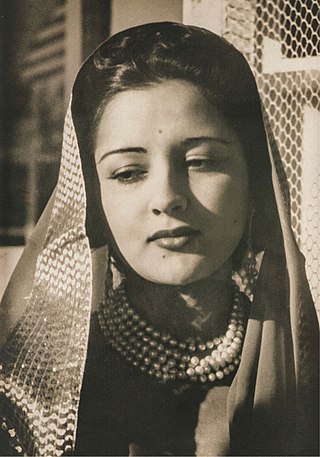
Princess Sita Devi, Princess Karamjit Singh of Kapurthala, also known as Princess Karam and the Pearl of India, was the wife of Prince Karamjit Singh, a younger son of King Jagatjit Singh I of Kapurthala in Punjab, British India. In 1944, she was awarded the Empire of India Medal for her work in raising funds for Indian soldiers in the Second World War.

The City Palace, Jaipur is a royal residence and former administrative headquarters of the rulers of the Jaipur State in Jaipur, Rajasthan. Construction started soon after the establishment of the city of Jaipur under the reign of Maharaja Sawai Jai Singh II, who moved his court to Jaipur from Amber, in 1727. Jaipur remained the capital of the kingdom until 1949—when it became the capital of the present-day Indian state of Rajasthan—with the City Palace functioning as the ceremonial and administrative seat of the Maharaja of Jaipur. The construction of the Palace was completed in 1732 and it was also the location of religious and cultural events, as well as a patron of arts, commerce, and industry. It was constructed according to the rules of vastushastra, combining elements of Mughal and Rajput architectural styles. It now houses the Maharaja Sawai Man Singh II Museum, and continues to be the home of the Jaipur royal family. The royal family has around 500 personal servants. The palace complex has several buildings, various courtyards, galleries, restaurants, and offices of the Museum Trust.The MSMS II Museum Trust is headed by chairperson Rajamata Padmini Devi of Jaipur. Princess Diya Kumari runs the Museum Trust, as its secretary and trustee. She also manages The Palace School and Maharaja Sawai Bhawani Singh School in Jaipur. She founded and runs the Princess Diya Kumari Foundation to empower underprivileged and underemployed women of Rajasthan. She is also an entrepreneur. In 2013, she was elected as Member of the Legislative Assembly of Rajasthan from the constituency of Sawai Madhopur.
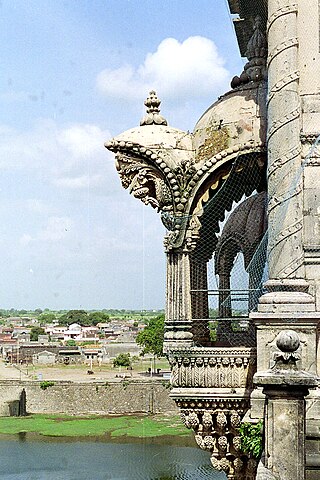
The Naulakha Palace, the oldest extant palace in Gondal, India, dating back to the 18th century (1748) during the reign of Haloji Sagramji, with a "sculpted facade" is a part of the Darbargardh fort complex. It is named "Navalakaha" meaning rupees "nine lakhs" which was the cost of building it at that time. It has stone carvings with "jharokhas" (balconies), a pillared courtyard, delicately carved arches, and a unique spiral staircase. The large chandelier-lit "durbar" hall witnesses stuffed panthers, gilt wooden furniture, and antique mirrors. The "private palace museum" displays an array of silver caskets which were in the services of carrying messages and gifts for the Maharajah Bhagwat Sinhji on his silver jubilee as ruler of Gondal. The palace is situated in Gondal city, which is well connected by road, rail and air services. It is located 38 kilometres (24 mi) away from Rajkot, which is also the airport and rail head.
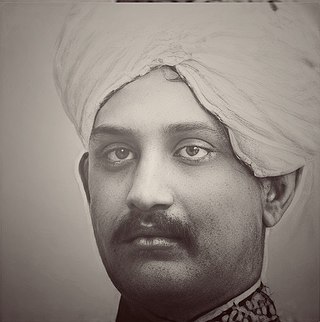
Maharaja Sri Rama Chandra Bhanja Deo was the Maharaja of Mayurbhanj State of India. Sc
Mayurbhanj Palace was the royal palace of Maharajas of Mayurbhanj, which was a princely state in British Raj. It is a heritage architectural monument and landmark of Baripada town, which was the erstwhile capital of the Mayurbhanj State.
Digvijaysinh Pratapsinhji Jhala was an Indian politician from Gujarat. He served as India's first environment minister in the central government.

Captain Sir Amarsinhji Banesinhji was the Maharana Raj Sahib of Wankaner from 12 June 1881 until his death on 28 June 1954.
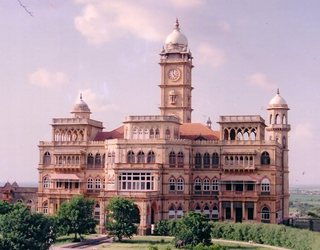
Ranjit Vilas Palace is the principal palace and, until 2012, the residence of the royal family of the princely state of Wankaner in what is now the Indian state of Gujarat.

The Umed Bhawan Palace in the outskirts of Kota, Rajasthan is a former residence of the Maharaja of Kota. Nowadays, the palace is partly converted into a heritage hotel. The palace is surrounded by a large park.
References
- 1 2 3 4 5 6 7 Sugich, Michael (1992). Palaces of India : a traveller's companion featuring the palace hotels. Internet Archive. London : Pavilion. pp. 89–90. ISBN 978-1-85145-520-1.
- ↑ Raulet, Sylvie; Garde, Anne (1997). Maharajas' Palaces: European Style in Imperial India. Vendome Press. p. 222. ISBN 978-0-86565-989-6.
- ↑ Baroda), Fatesinhrao Gaekwad (Maharaja of (1980). The Palaces of India. Vendome Press. p. 183. ISBN 978-0-86565-007-7.
- ↑ Bradnock, Robert; Bradnock, Roma (1996). India handbook. Internet Archive. Lincolnwood, IL. : Published in North America by Passport Books. p. 1367. ISBN 978-0-8442-4908-7.
- ↑ Alastair Sawday's special places to stay, India. Internet Archive. Bristol : Alastair Sawday. 2003. p. 96. ISBN 978-1-901970-41-8.
{{cite book}}: CS1 maint: others (link) - ↑ The Penguin guide to the monuments of India. Internet Archive. London, England ; New York, N.Y., USA : Viking. 1989. p. 399. ISBN 978-0-670-80696-6.
{{cite book}}: CS1 maint: others (link) - ↑ "Royal Oasis Wankaner". gujrattourism. Retrieved 13 January 2025.